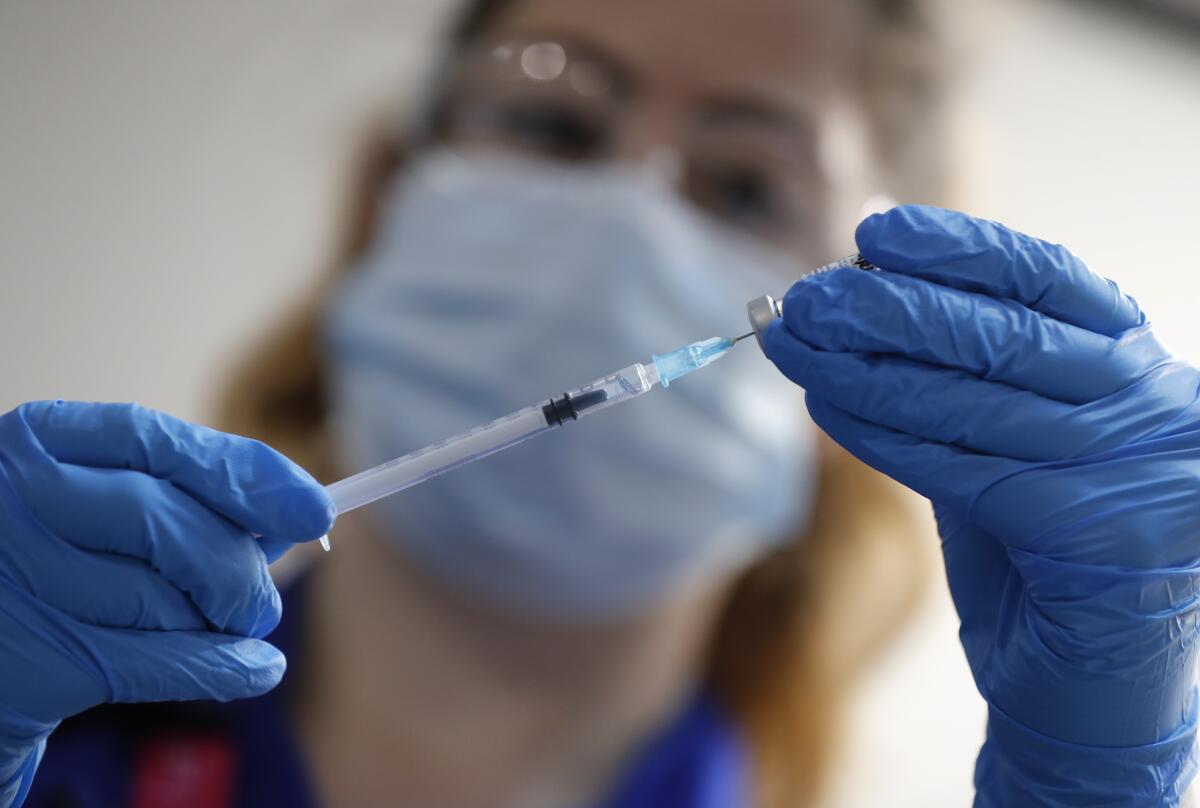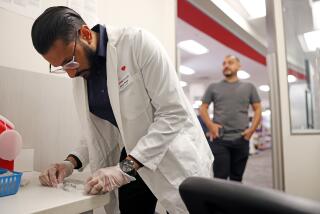Coronavirus variant from Brazil found in California

A coronavirus variant from Brazil has been detected in a sample from the Bay Area, underscoring the urgency of ramping up inoculation efforts as researchers try to learn whether it, as well as others circulating in California, could undermine the effectiveness of COVID-19 vaccines.
Researchers at Stanford’s Clinical Virology Laboratory screened nearly 1,000 specimens during the last two weeks and found one case of the Brazil variant, known as P.2, said Dr. Benjamin Pinsky, the laboratory’s medical director. They reported the finding to public health authorities Jan. 25.
The researchers also identified four cases of a variant from the U.K., B.1.1.7, that appears to spread more easily, may be more virulent and is already known to be circulating in California, Pinsky said. And they found that about 29% of the specimens had the L452R mutation, a feature of a homegrown variant that has been increasingly detected across the state and may have helped drive the most recent case surge.
“It’s definitely possible that they already contributed to the humongous surge we’ve seen over the last six weeks or so,” said Dr. Edward Jones-Lopez, an infectious-diseases expert at USC. “And it could get even worse if these strains are indeed fitter than previous strains and people lower their guard and we are not very logistically efficient in delivering vaccines.
“When we put those two factors together, it might still be a rough next two to three months.”
The P.2 variant is distinct from another detected in Brazil, P.1, that was linked to an abrupt resurgence in cases in Manaus that took place after much of the population was already believed to have been infected. But the variants share a mutation that appears to help the virus evade antibodies generated by either a previous infection or a vaccine, Pinsky said.
And there are at least two examples of people being infected with the P.2 variant after they had been infected by another strain, a feat that has been demonstrated by P.1 and multiple other coronavirus strains. That finding has led researchers to theorize that P.2 may have similar properties as the P.1 variant, he said.
“There’s a lot less known about the Brazil P.2 strain, so that’s one to keep an eye on,” he said.
The variant appears to have been present in the United States for some time but has attracted less attention than others.
Though just one case of the P.1 variant has been detected in the U.S., in a Minnesota resident who had recently traveled to Brazil, 25 cases of the P.2 variant have been identified in multiple states, according to the federal Centers for Disease Control and Prevention.
In addition to the case in the Bay Area, at least three others have been detected in California, two in samples collected in the San Diego area in late November and early December and a third collected from an undisclosed location Jan. 8, according to information Stanford researchers obtained from a public genomics database. The California Department of Public Health said it has received only one report of a case in the state.
The variant has also been found in Florida, Georgia, Illinois, Kentucky, Massachusetts, Nevada, New York, Puerto Rico, Texas, Virginia and Wisconsin, according to the database, with the majority of the specimens collected in January.
Scientists are watching the Brazil and U.K. variants, as well as another strain, B.1.351 from South Africa, because they share a similar set of mutations that tweak the so-called spike protein on the coronavirus’ surface. The resulting changes appear to help the virus enter human cells, said Paula Cannon, virologist and professor at the Keck School of Medicine of USC.
It’s also possible that such mutations could alter the spike protein enough that antibodies are less able to recognize it, she said. Laboratory tests have suggested the Pfizer-BioNTech and Moderna vaccines are still effective against the U.K. variant but may have lower efficacy against the Brazil and South Africa variants, Cannon said. Recent data have also indicated that two other COVID-19 vaccines are less effective against coronavirus strains in South Africa.
Still, she noted, “immunity, whether it’s from a vaccine or a prior infection, is kind of a continuum,” meaning that even if a person contracts the virus after they’ve developed antibodies, they’re likely to have a much less severe infection.
“A less-than-perfect immunity is still massively better than no immunity at all,” Cannon said. “Even if all that these vaccines do is stop people from getting seriously ill and going to the hospital, boy, that’s a win.”
In fact, experts say, the circulation of the variants means it’s crucial to vaccinate as many people as possible as quickly as possible to stave off additional mutations that could make the virus that much more difficult to contain.
“We don’t want these things kicking around and being transmitted and then getting into somebody who’s immunosuppressed and carries it for three weeks, because that’s how you really start to accumulate mutations,” said Dr. George Rutherford, an epidemiologist and infectious-diseases expert at UC San Francisco.
“It’s not a time to be hesitant about getting vaccines,” he added.
So far, the South Africa variant has been detected in the U.S. only in South Carolina and Maryland, according to the CDC.
But it’s impossible to say exactly how widespread any of these variants are because there’s no comprehensive surveillance system to detect them, and labs that conduct such screening are unevenly distributed.
“We really dropped the ball on this,” Cannon said. “It wasn’t made a priority to do a lot of surveillance to look and see if the virus was mutating, and that’s been a problem all over the world.”
California has established a network of labs that are sequencing viral genomes to identify variants and better understand the virus’ evolution, the state Department of Public Health said in a statement. The labs — including at the Chan Zuckerberg Biohub, Invitae Corp., UC San Francisco and Scripps Research Institute — have together sequenced several thousand specimens, the statement said.
Experts expect a much more comprehensive picture of the variants to soon emerge.
“Those studies are now occurring at a rapid pace, and we will know in the next few weeks the relative distribution of the different strains,” USC’s Jones-Lopez said.
The B.1.1.7 variant was first identified in England and had made its way to the U.S. by late December. The CDC has warned that it could become the dominant strain in the U.S. by March.
As of Sunday, a total of 467 infections caused by the U.K. strain had been detected in 32 states, according to the CDC. That includes 113 cases in California, which has reported cases involving B.1.1.7 in Los Angeles, San Diego and San Bernardino counties as well as in the Bay Area.
The homegrown variant, which scientists have dubbed B.1.426, is believed to be propagating more quickly than any other in California. State public health officials announced last week that it was being increasingly identified by genomic sequencing and had turned up in about a dozen counties. It has been identified in several large outbreaks in Santa Clara County, which health officials have described as a red flag in need of further investigation.
The variant does not share the mutations seen in the U.K., Brazil and South Africa strains, and it’s not yet clear whether it’s more infectious or might blunt the effect of antibodies, Cannon said.
“The only thing we’re going on here is the fact that it’s spreading through the population, which suggests it might have found a different way to be a more infectious virus,” she said. “The fact that it seems to be becoming a dominant strain in California is a smoking gun that it may be more infectious, but we don’t know that for sure.”
The B.1.426 variant has a different mutation that also affects the spike protein, and antibody experiments suggest that viruses harboring such a mutation may be less susceptible to neutralization, “so there is concern that vaccination may be less effective at fighting that particular variant,” Pinsky said.
The L452R mutation is one of five in the B.1.426 strain, which researchers stumbled across while testing California samples for the U.K. variant. They found that although the homegrown strain had been barely detectable in early October, it accounted for 24% to 25% of samples gathered throughout California in the last weeks of 2020. Its sudden prominence led them to theorize it may have been partly to blame for the worst surge to hit California so far, which has only recently begun to abate. The strain has also been detected in New York, Washington, D.C., and Oregon.
“Ultimately, for the average Angeleno, this doesn’t change necessarily what you do — it just reinforces the importance of doing these public health measures and following the guidance,” said Dr. Annabelle de St. Maurice, co-chief officer of infection prevention at UCLA Health.
Non-pharmaceutical interventions such as wearing a mask, staying away from others and washing one’s hands are known to be effective against the virus, regardless of the strain, she pointed out.
“I know we’re all tired at this point in the pandemic,” she said, “but these are still the most important things we can do to protect ourselves against COVID.”
More to Read
Sign up for Essential California
The most important California stories and recommendations in your inbox every morning.
You may occasionally receive promotional content from the Los Angeles Times.











